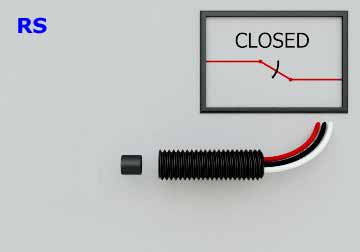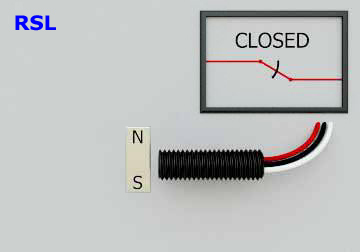Sensor Solutions offers Reed Switches with varying sensitivities and power switching capabilities with normally open or normally closed outputs as well as Bistable Reed Switches with a latching output. Sensor Solutions Reed Switches are low-cost sensors for detecting magnets to confirm proximity, alignment, or position.
There were no results for "".
If you are searching for a part number from a sensor engraving, you may be including a date code, gear pitch, or programming code.
Try searching again without any characters after an "_" or a blank space on the markings.
You may also find the product or information you need on one of the below pages:
For immediate assistance, please call us at: 970-879-9900.
Reed Switch Sizes and Ratings
Reed Switch Sensors are magnetically activated mechanical switches. The size of the switch determines both the sensitivity and the amount of power the sensor is capable of switching. Reed switch sensitivity is defined in Amp Turns (AT). The lower the AT value, the smaller the magnetic field will be that is required to switch the sensor. Sensor Solutions offers the following sizes and ratings.
- RS1 switches are normally open and operate at 8-16 AT and are rated at 200V AC or DC. 750mA, 10W.
- RS2 switches are normally open and operate at 32-38 AT and are rated at 200V DC, 1.5A, 50W.
- RS3 switches are normally open and operate at 47-68 AT and are rated at 400V DC, 3A, 100W.
- RS3L latches close when detecting 47-68 AT from the South Pole and are rated at 400V DC, 3A, 100W. They require an equivalent size North Pole field to release.
- RS4 switches are normally open and operate at 5-15 AT and are rated at 175V DC, .35A, 5W.
- RSDT switches operate at 15-25 AT and are rated at 175V AC or DC, 250mA, 5W. RSDT switches are available as Normally Closed, Normally Open, or Dual throw.
Other sensitivities of Reed Switches can be custom ordered, contact our applications engineers to discuss options for the Reed Switch that will best fit your specific requirements.
How Does a Reed Switch Work?
As a low cost, passive magnetic switch, Reed Switches are commonly used in applications to confirm a target is in the proper location, such as door and window alarms in security systems. For a normally open reed switch when aligned properly with a magnetic field, the blades inside the switch body move together to allow current to flow through the switch. When the magnetic field is removed the blades move apart to open the circuit. Latching or Bistable Reed Switches are also available where the sensor “closes” the circuit when one magnetic pole is detected, but the circuit remains closed until an opposite pole magnetic field is detected.
Is a Reed Switch the right technology for the application?
Benefits of using Reed Switches are they are simple, low-cost sensors for confirming a target is in the proper position. They are passive 2 wire sensors that do not require a power source and can be connected to applications easily as a relay. Adjusting the switch point for a reed switch can be accomplished by changing the position of the sensor face relative to the target magnet, or by changing the size or grade of the target magnet.
The primary drawback of using reed switches is that they are a mechanical switch that will eventually wear out. As the amount of power being switched increases, the number of switching events before it fails decreases. Therefore these sensors are not recommended for tracking speed, or high-frequency counting. A reed switch is also more sensitive to shock and vibration than a solid state Hall Effect sensor.
If you are not sure whether a reed switch is right for your application, or if you would like to discuss reed switch and magnet combinations, contact Contact our Applications Engineers and we can work together to determine the best sensor for your requirements.
Reed Switch vs. Latching Reed Switch
Standard Reed Switches can be activated by either a South or North Pole magnetic field. Once the field is no longer present the Reed switch will return to it's normally open or normally closed state. Latching Reed Switches, are bistable and will activate when a South Pole magnetic field is introduced, but they will not release until a North Pole magnetic field is introduced.
Magnets for use with Reed Switch Sensors
The operate detection range for a Reed Switch and a permanent magnet is dependent on the size, shape, and grade of the magnet as well as the orientation of the sensor relative to the magnet and the direction of motion. Magnetic fields are typically measured in Gauss, but Reed Switch sensitivity is described in Amp Turns. To determine the appropriate sensor and magnet of a given application, Contact our Applications Engineers to discuss the specific requirements.
A large variety of target magnet options are available in our Accessory Catalog. We offer raw magnets with the South Pole Marked as well as magnets built into threaded bolts for mounting in threaded holes and magnets mounted into clamping shaft collars for easy installation on smooth shafts.


